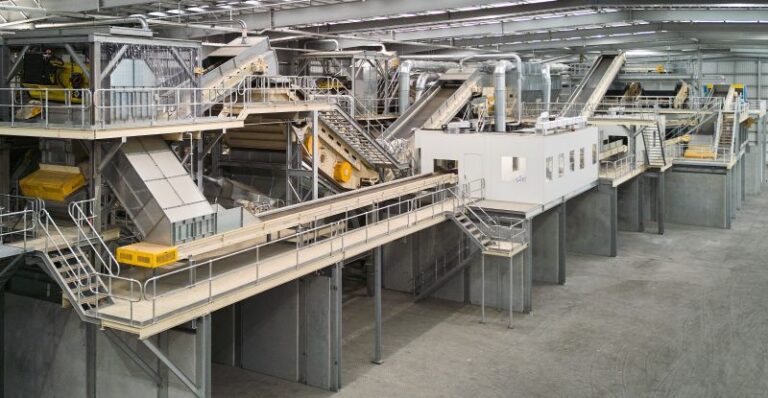The Future of Waste Management: Trends and Innovations in Recycling Equipment

Investing in the right waste management equipment is crucial in today’s rapidly evolving landscape. Outdated systems can lead to higher costs, inefficiencies, and missed opportunities to adopt sustainable practices. Older systems often lack the efficiency and flexibility to handle the diverse materials requiring recycling today, resulting in increased labour, energy, and maintenance expenses. However, new innovations in recycling equipment – such as AI-powered sorting systems, and automation are transforming the way businesses manage waste.
So, how can you ensure your investment delivers results? In this blog, we’ll explore current waste management trends, innovations in recycling equipment, and how they address today’s challenges while preparing for the future.
State of Waste Management in Australia
Australia generated 75.8 million tonnes of waste in 2020-21, a 3% increase from the previous year. The largest contributors were construction materials, organics, and hazardous waste. Despite recycling initiatives, the national recycling rate has plateaued, underscoring the need for more efficient systems to handle increasing waste volumes.
The federal government is addressing these challenges through its $250 million Recycling Modernisation Fund (RMF), which supports upgrades and new recycling facilities. This forms part of a broader $1 billion initiative aimed at boosting Australia’s recycling capacity by over one million tonnes annually. While these measures signal progress, continued innovation and investment will be key to meeting future waste management demands.
Current Trends and Innovations in Recycling Equipment
AI and Machine Learning in Sorting Systems
AI and Machine Learning have revolutionised sorting systems, making recycling faster, more accurate, and efficient. Advanced technology and image recognition technology enable these systems to identify and separate materials like plastics, metals, and glass, reducing contamination. Many systems integrate with robotic arms to handle various materials, improving speed and accuracy. AI systems also adapt over time, learning to process new materials and meet emerging challenges.
Waste-to-Energy (WTE) Technologies
WTE technologies offer a sustainable solution for non-recyclable waste by converting it into energy. Common methods include:
- Incineration: Burns waste to generate heat and electricity, reducing waste volume by up to 90%.
- Gasification: Converts waste into syngas for electricity generation or use as a chemical feedstock.
- Anaerobic Digestion: Processes organic waste to produce biogas for energy and nutrient-rich digestate for fertilisers.
These technologies provide businesses with alternatives to landfilling while generating usable energy.
Smart Recycling Bins
Smart bins use sensors to monitor waste levels in real-time, notifying collection services when full, optimising collection routes and schedules. Additionally, smart bins collect data on waste patterns and often feature displays to educate users about proper recycling practices, boosting recycling program participation and efficiency.
Circular Economy Solutions
Circular economy practices aim to reduce waste and extend the lifecycle of materials. Key innovations include:
- Digital Platforms for Resource Sharing: Digital platforms for sharing resources are changing how businesses manage waste and byproducts, particularly in cardboard and paper recycling. These platforms connect businesses to exchange materials turning one company’s waste into another’s resource.
- Biodegradable and Regenerative Materials: Compostable packaging, mycelium-based materials, and fibre-to-fibre textile recycling are reducing environmental impact.
- AI-Driven Design: AI helps design products that are easier to recycle or repair, promoting sustainability and reducing waste.
Plastic Recycling Innovations
Here are some recent plastic recycling innovations that are improving the process-
- Plastic Waste for 3D Printing: Recycled plastics like PET and HDPE are converted into filaments with industrial shredders for 3D printing, creating prototypes, tools, and even furniture.
- Enzymatic Recycling: Specialised enzymes break down plastics like PET into reusable components, maintaining material quality.
- Microbial Plastic Degradation: Bacteria and fungi consume plastics, offering potential for addressing hard-to-recycle waste.
Sustainable Waste Management Solutions
Equipment and Conveyors for Recycling Plants
Selecting the correct equipment to process waste material is critical to maximise recovery, purity while operating efficiently and maintaining uptime. Understanding how material behaves while being processed and the risks involved with not applying suitable process flow can have an adverse effect on the outcomes you are trying to achieve.
Modern conveyor systems for waste management and recycling solutions are modular and energy-efficient, reducing power consumption while enabling businesses to scale operations with minimal disruptions ensuring uptimes and capability through the plant.
The Bottom Line
When investing in waste management equipment, aligning your choices with industry trends and sustainability goals is crucial. The right equipment can improve efficiency, reduce costs, and help achieve long-term environmental objectives. Take the time to research emerging innovations and make informed decisions that will future-proof your business.